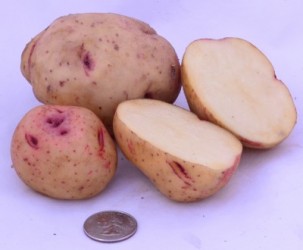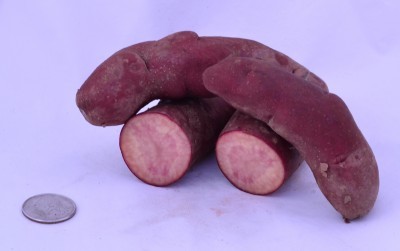A Potato is a Potato, is a Potato, Right? Considerations for Ordering Seed Potatoes
Hello all,
I am delighted to announce that we have a new voice joining us on the blog. Erin Schneider, M.ED, is a farmer, educator, and fruit lover. Erin co-owns and stewards Hilltop Community Farm, a diversified CSA (community supported agriculture) farm and orchard in La Valle, WI where she specializes in agroforestry and unique varieties of Midwest fruits. For the past 16 years Erin has supported research, teaching, and managing, agriculture and conservation education programs that further innovation and capacity for farmers and their communities.
In addition to the people, plants, and dirt-scapes she loves and tends to, Erin loves to write, cook, and canoe and is excited to contributing to the Potato Blog. She is a member of Wisconsin Farmers Union, Farmers Raising Ecologically Sustainable Healthy Food, and a North American delegate for the World Farmer Organization – Women in Agriculture Committee.
– Ruth
A Potato is a Potato, is a Potato, Right? Considerations for Ordering Seed Potatoes – Erin Schneider
I am sitting at my dining room table, trying to create some semblance of order between the stacks of seed catalogs and field notes as I put the finishing touches on this year’s seed order. For the farmer and market gardener, seed is a big investment – not only do you have to consider which varieties are best for you and your markets, but seed quality can have a huge impact on the quality and productivity of your crops. This is especially true when it comes to potatoes. But what goes into decisions about choosing varieties? Where do you start? What if, after thoroughly assessing a few new varieties you are still on the fence?
Coffee in one hand, pencil in the other, I sort through spreadsheets from last year’s field, production, and sales notes weighing worked, what didn’t, and what might I experiment with to keep things fresh and intriguing for my market customers and myself. I diligently read through potato descriptions in catalogs trying to keep a healthy level of skepticism and not be seduced solely by catalog claims. Before, long, I realize there’s a lot to digest! I know our CSA members enjoyed the different colors and shapes of having red, white, and blue fleshed potatoes in their mid-season shares, and that Kennebec and Yukon Gold have consistently stored well through the winter. Yet, I just couldn’t say no to Australian Crawlers for their incredible yield despite scab at the surface skin or the funky shape of Papa Cacho (who knew a potato can remind you of a hot dog?). While taste, customer satisfaction, storability, yield, color, and shape are all important traits to consider, one of the most important decisions with potatoes is making sure you choose and can obtain high quality seed.


This starts with purchasing high quality certified seed potatoes from a good seed potato grower. The thrifty German in me grudgingly gave into this need for certified seed potatoes. Before I made the transition from gardener to market farmer, the prospect of actually buying seed potatoes seemed like a waste of time and money. It took a few crop failures to drive home the point that maybe I was planting unreliable or virus laden seed. Our colleague Doug Rouse shared a similar observation from a local Amish farmer. One of his favored varieties was Red Thumb, a specialty fingerling potato variety that did well for his local markets. The seed, however, was a big investment. His solution was to save seed from the previous year’s crop. This worked well 2, 3, sometimes 4 years in. But a pattern emerged: every ~ 3 – 4 years would bring a crop failure and he never knew what year it would be – and then it would be time to buy seed potatoes from off the farm. The likely culprit was probably Potato Virus Y. Accumulation of pathogens from year to year will eventually cause crop failure, which used to be called “run out”, as this 1922 agricultural bulletin shows. If at least 90% of seedpieces emerge, most potato varieties will still yield well as individual plants fill in the open space, but at lower levels of emergence you start to wonder whether you made the best decision with the variety or something is running amok with your seed supply. Last year’s growing conditions can also affect how the seed potatoes perform this year. A good rule of thumb, red, yellow or otherwise, is to ask your supplier what the field conditions were including yields, visual quality, plant health, and stress during the growing season—and to purchase certified, high quality seed potatoes.
A note on certification:
Organic growers in the US are required to plant organically produced seed and planting stock, unless it is commercially unavailable (NOP rule §205.204). It’s important to note that organic certification and seed certification are two separate processes, so that seed potatoes that are certified organic are not necessarily certified for low disease incidence. Seed potatoes that are both certified organic and certified for use as seed are increasingly available, and are sometimes referred to as “double certified”. At the very least, certified seed should stand behind the claims that potatoes were inspected and tested (twice during the growing season, and ideally once during the winter) to ensure that they have a low incidence of tuber-borne diseases, and that the variety is correctly identified. Seed potato certification programs focus on viruses, for which the tolerance level is 5% (Wisconsin seed rule; virus thresholds for seed potatoes produced in some other states are higher) and on a small set of highly destructive pathogens for which there is zero tolerance (e.g. spindle tuber viroid and bacterial ring rot). If you’re in any doubt, ask the seed producer to clarify the certification status of their seed lots.
Sometimes, even after purchasing ‘double certified’ seed you can still get a wildcard. Those who participated in the 2014 Variety Trials may recall that we had to recall and unearth the French Fingerlings. Even though they were certified seed, purchased from a seed grower (not from Wisconsin!) about 80% of the plants had PVY as attested by field symptoms and confirmed by lab testing. We hope to avoid this during our 2015 Variety Trials by more carefully vetting our seed sources. If you are interested in experimenting with us, you can learn more about opportunities to participate in 2015 Variety Trials or contact us.
If you’re still on the fence about introducing new varieties into your production plans yet curious about planting ‘Magic Molly’ (a mid-season purple skin and flesh variety) or ‘Red Maria’ (a red skin, white fleshed variety that might fill a new niche at your stand) or the dozens of other varieties that lure you in, you can conduct your own small-scale variety trial. I would suggest purchasing 2 – 5 lbs of any particular variety you are interested in. We will discuss variety trials in further detail for a future blog post.
Having thoroughly assessed aspects such as field conditions, certified seed, suppliers, your market needs, and budget you ready to place your order. No need to sweat as you sign the check, you should feel confident in your decision(s). Sit back, relax, and imagine the colors, shapes, textures, tastes, uses, and storability when the ground slowly wakes up from its deep frozen sleep.
And one last tip, once your spuds have arrived, if they are to be stored for any length of time before cutting, keep at 40-42 F in well ventilated conditions at 85-90% humidity. Separate bins are recommended for different lots.
We want to hear from you! What goes into your own decision-making about choosing potato varieties? What tips would you offer other farmers?
What would you like to see our variety trial research focus on? Aesthetics? Taste? Marketability? Size? Storage? Other? Please feel free to share your comments below and be in touch with us.
Learn more:
From the archive (January 2014): More perspectives on purchasing seed potatoes.
Results from 2014 Variety Trials
Links to finding certified seed suppliers:
Wisconsin Potato and Vegetable Growers Association
Wisconsin Seed Potato Improvement Association
Bona Vide Organics – Links to Organic Seed Potato Suppliers
The presence of a nursery or supplier in the above list does not mean or guarantee that all (or any) of their seeds or plants or other products are certified organic. Always ask a nursery or grower for certification status and any other relevant information regarding their product.
This article was posted in Blog Posts and tagged certified seed potatoes, organic seed potatoes, potato virus Y.
Comments are closed.